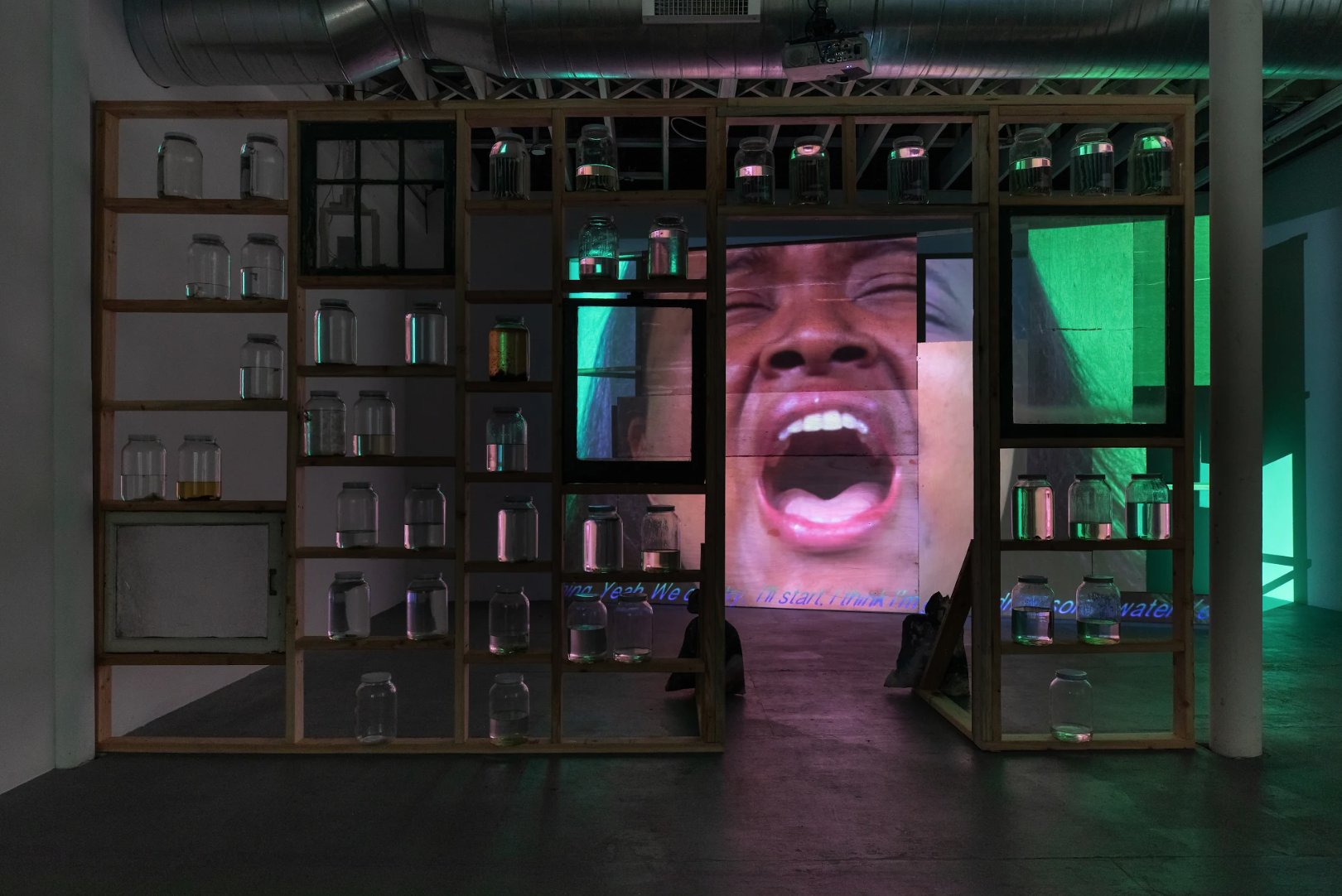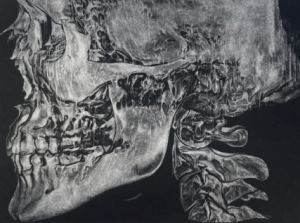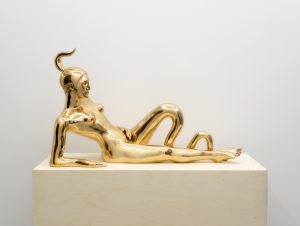Katherine McKittrick’s Demonic Grounds is a book about spaces — interior and exterior geographies, and the porous delimitations between the two for Black women. There’s truth here for: Black femmes, for Black queer and trans people, for all Black folx who have a kinship with femininity. We’re speaking of the expanses, excesses, and terrains of femininities, how Blackness and femaleness can become the story of jouissance laced twice round; once upon the interior and the other, like a wave upon Fanon’s epidermal script. As McKittrick describes in analysis of Linda Brent’s narrative, it’s the socially enforced mystery laid over one’s voice.
Question: What happens when the mystery shapes you and you in turn shape the mystery?
An Answer: Exist, exceed, manifest the ineffable. Think kin, think the sociogenesis that makes and unmakes, think Sylvia Wynter’s humanity, unsettle the centrality of man. Make friction. Friction is what sparks life.
Curator Stephanie Koch takes McKittirck’s work as a theoretical point of departure for the exhibition split my sides, currently up at The Luminary in Saint Louis, Missouri. split is an exploration of Black trans and feminine interiorities, the landscapes of the self, and how those geographies present liminality as possibility. The line between theory and life is porous and malleable. Remember the Combahee River Collective, “the personal is political”. The title of the exhibition is homage to the Maya Angelou poem and performance “The Mask”, a piece itself inspired by late 19th poet Paul Lawrence Dunbar’s work, “We Wear the Mask”. Both pieces are meditations on survival: the mask is a mask of continuance, of being, of moving, of living in a world that contrives of a Blackness closer to death than life.
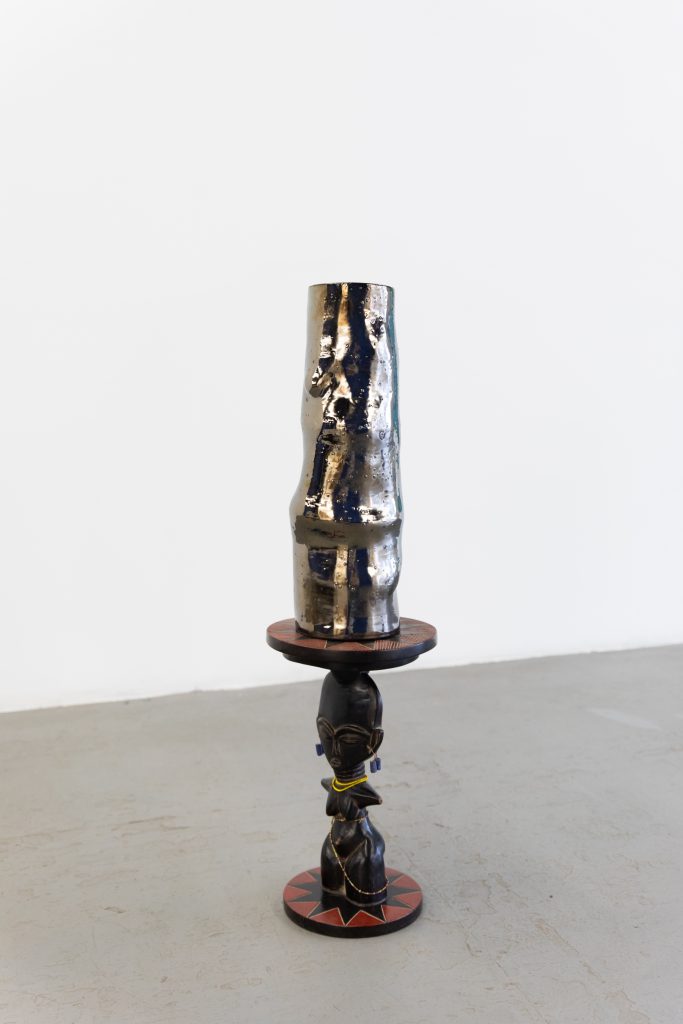
Question: Where is the boundary between life and death? Does it mark the land like grooved rock? Is your surface the map to trace its tributaries? What happens when those boundaries are denied, upset, unturned, forced asunder?
An Answer: Make a history, find your history. Say yes to what you’ve seen, where you’ve been, and where yet you’ll be.
The exhibition, featuring the work of Lola Ayisha Ogbara and Amina Ross, presents conceptions of space and affect as tactile and relational; the heart of these senses of self are presented through sound, film, sculpture, and performance. These architectures in turn provide viewers glimpses of feminine, queer, and trans identities through stages of life, childhood to adulthood, there and back again. Relationality in split, however, does not just operate on a single valence, audience to artist. Rather the work of Ogbara and Ross are confrontations between the self and the Other: the self makes itself known through the eyes of another. However, what then does one do in a world that punishes Blackness, girlness, queerness, transness? Where does the self go, how is it made and unmade? The artists both turn to family and kin, subaltern histories that have informed their own conceptions of identity.
Throughout the show Ogbara has pieces in which naturalistic, ceramic forms sit upon pedestals created from found and repurposed materials. These sculptures are named for both Ogbara’s relatives, friends, and Black women throughout history. The ceramic forms and their corresponding pedestals, their “seats”, are landmarks as they function to reconfigure what rest and respite, what comfort and care can look like for the women who touched and shaped the artist’s history. As sites, as talismans of care and protection, Ogbara’s sculptures position the idea of home as one of possibility — home can be a person, an idea, a way to remove the masks of the world. Home here is a way to resist, to live.
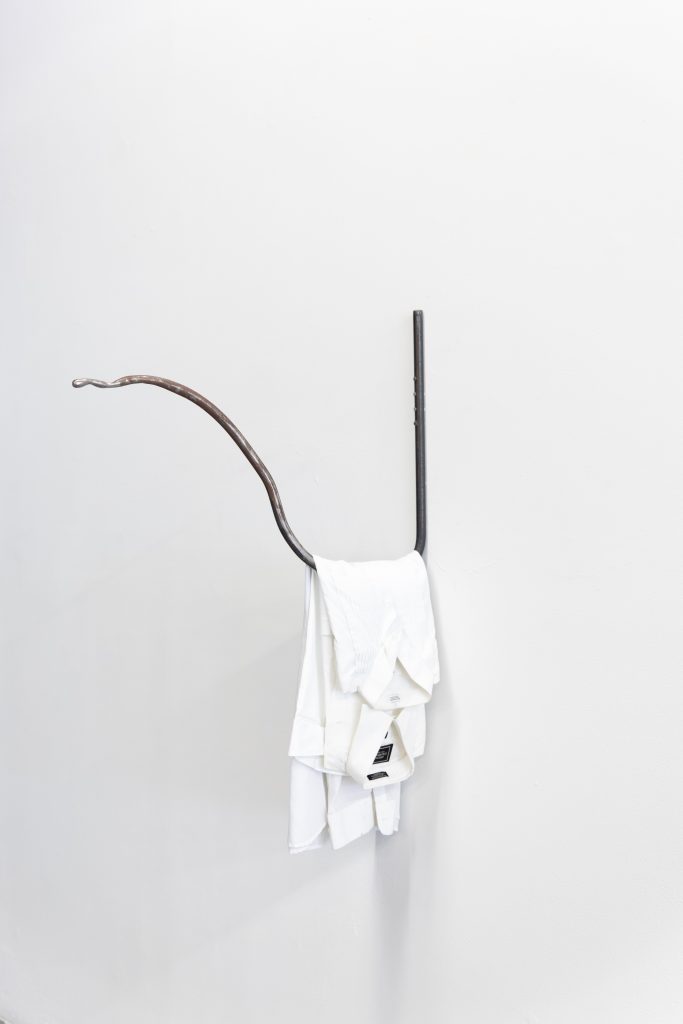
Ogbara not only explores history but turns a critical lens to its making, its absences, the voices both lost and found, in work such as: Bubblegum, Bubblegum, Double Dutch Queen + Hopscotch (A Safe Place to Land), and the sound installation, A Bellow of My Laughter pts 1 & 2. Though these pieces are created through varied, disparate methods and materials (iron casting, ceramic stoneware, audio channels, etc.) the three pieces interrogate the power dynamics of sex, gender, and play for Black women, femmes, and young girls. These pieces form a repository of relics, memories informed by a deep ambivalence in which pleasure and pain are intertwined like tightly bound rope and laughter can emerge from your cries.
Kin to Ogbara’s call, wish, and manifestation of care is how Ross engages craft, histories, and intimate intertwinings. In Rest (Refrain), two crisp white button ups rest upon a naturalistic steel form undulating outward and upward from The Luminary’s wall. These shirts, commonly worn by people within the service industries and the shirts themselves made through hours of unseen artistry, are a reference to the artist’s grandmother, Patricia Russell. Russell and Ross collaborated together on the piece Earthward (Reprise), a built environment with checkered opalescent squares. Earthward is a space of possibility; it could be a game board, a dance floor, both, or neither. The piece’s use and all its myriad possibilities, are secondary to the fact that it is a relational zone — a space for physical and affective convergence. You merge here. Time and effect are not bound by linear constraints; each looping square of fabric digitally printed by Ross and Russell’s waterfalls of hand-sewn embroidery.
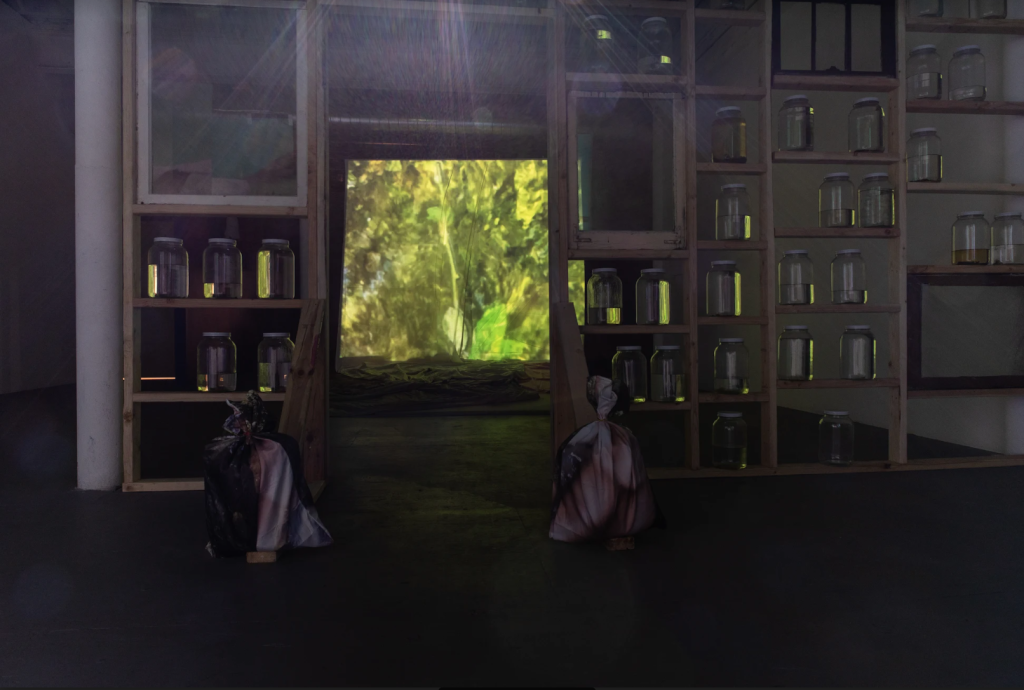
Ross’ interest in histories and both the limitations and excesses of physicality, are channeled through networks, systems; the multi-faceted and many-branched. There is a specific investment in the transformations and shifts inherent to connection. How one changes and shapes surroundings, how one is changed and shaped in return. What do you see? What do I see? Can the two meet? Is there friction, or can you feel water gliding on water, the coalescing of forms? Boundaries can be transgressed, splits we live with; the liminal is a condition of wanting, needing, being in this world. Queerness in Ross’ hands and in their gaze is time both frozen and unstuck. A single moment that presents the myriad possibilities of being.
In “Sonic Rupture: songs for(e) the swarm, an evolving architecture, a wooden structure holds various containers of liquids and diaphanous fabrics. A screen projects the image of actor, Yel Rennals, a frequent Ross collaborator, from their collaborative performance Emotional Weather.
The performance itself is described by Ross as “an exercise in emotional range.” Rennals face changes, shifts, transforms, depending upon a viewer’s perspective. The liquid and the fabric, both capture and release; frozen moments, expressions, pinpricks of the performer’s humanity shine like the midnight flashing of fireflies.
In Maya Angelou’s performance of “The Mask”, listeners do not know if either Angelou or the woman to whom the performance is dedicated are laughing, or crying, or screaming by the piece’s end. That irresolution is the heart of the work, it is the heart of the exhibition. Shifting tides of emotion, the ambiguity of experience(s), those conflicts inherent to the interior, they all are what it means to split, to shatter, to be a human in this world.
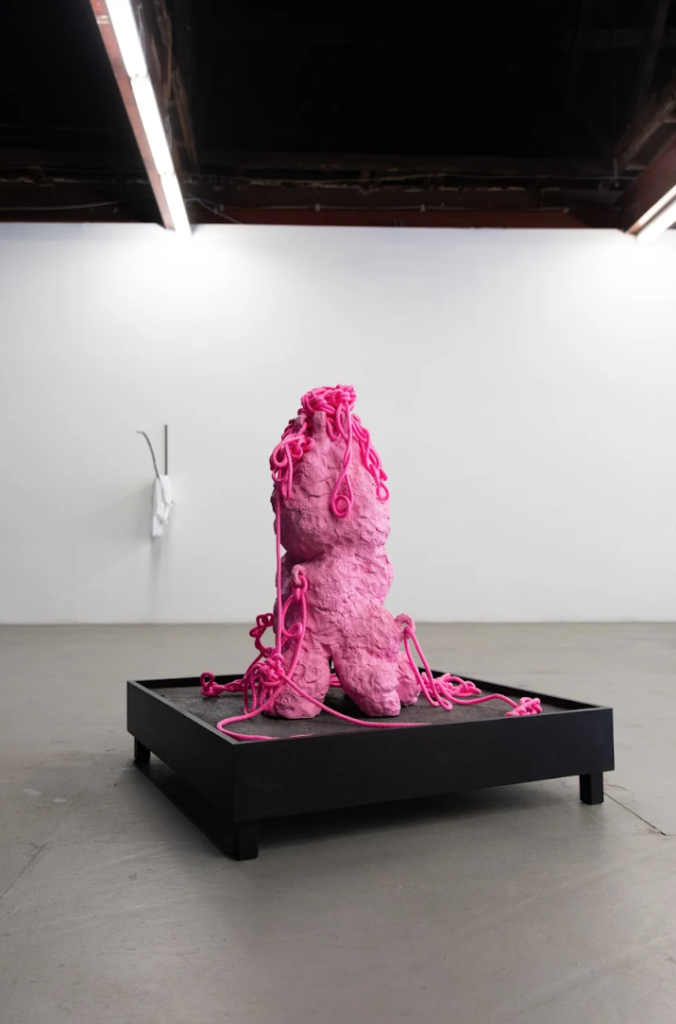
split my sides is on view at The Luminary from April 9 through July 16th, 2022.
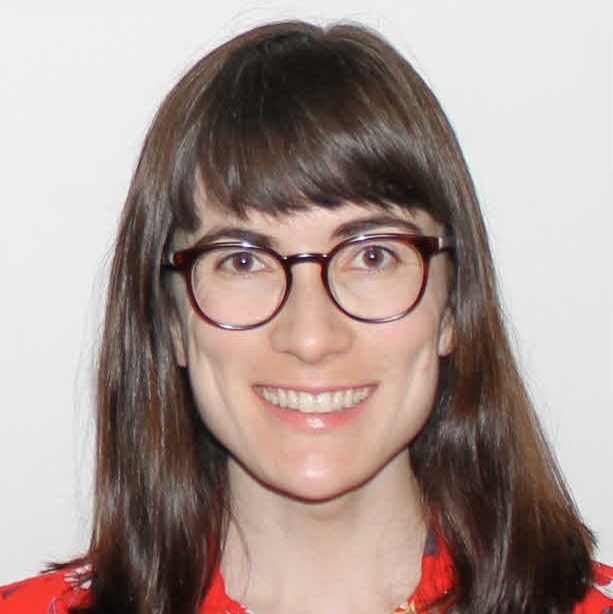
Annette LePique is an arts writer and Lacanian. Her interests include the moving image and jouissance. She has written for Newcity, ArtReview, Chicago Reader, Stillpoint Magazine, Spectator Film Journal, and others. She has a background in dance and music.
